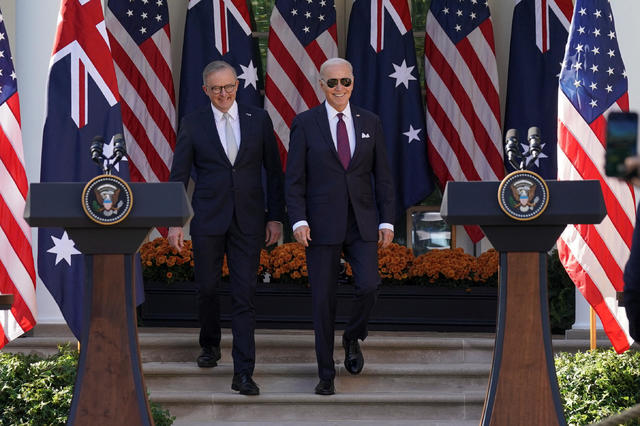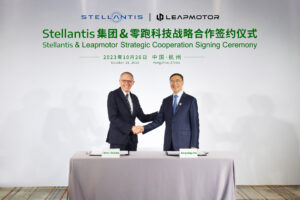In a move aimed at enhancing security and bolstering defense capabilities in the Asia-Pacific region, the leaders of the United States and Australia recently announced an expansion of their defense cooperation to include Japan, focusing on the development and integration of unmanned aerial vehicles (UAVs), or drones. The partnership, which was confirmed after a meeting at the White House between U.S. President Joe Biden and Australian Prime Minister Anthony Albanese, is a response to the ever-growing military might of China and seeks to strengthen the interoperability of their forces.
This new collaboration is set to accelerate technology transfer and foster the growth of autonomous drones in the field of “collaborative combat aircraft and autonomy.” This concept, championed by the U.S. Air Force, encompasses a range of autonomous drone operations, as well as the synergy between manned and unmanned aerial vehicles in combat scenarios.
While specific details regarding the partnership were not disclosed, this initiative follows the Pentagon’s recent unveiling of its “Replicator” strategy, designed to deploy thousands of cost-effective autonomous drones within the next two years. The primary objective of this initiative is to offset China’s military superiority in terms of personnel and conventional equipment.
Unmanned aerial vehicles have become essential tools in modern warfare, capable of operations on land, in the air, and at sea. Drones minimize human risk while significantly enhancing the operational capabilities of armed forces. Several nations are actively developing collaborative aerial systems that allow multiple drones to not only support combat aircraft but also perform independent missions such as reconnaissance, electronic warfare, and precision-strike operations.
Australia’s Loyal Wingman project is a prime example of such developments. A joint effort by Boeing Defence Australia and the Royal Australian Air Force, this initiative has led to the creation of the MQ-28A Ghost Bat autonomous drone, which is currently undergoing testing and is expected to enter RAAF service in the near future. The partnership with Japan builds upon their previous agreement to work on autonomous systems that could complement Japan’s next-generation fighter program.
The joint statement issued by President Biden and Prime Minister Albanese also highlighted Australia’s involvement in large-scale command-post exercises, Yama Sakura in December and Keen Edge in February, both to be conducted in Japan alongside U.S. and Japanese forces. These exercises signify the growing military engagement between Australia and Japan, a result of the Reciprocal Access Agreement signed early last year. This agreement provides the legal framework for deeper bilateral cooperation and aligns with the United States’ vision of creating a “networked” security architecture in the Asia-Pacific region.
The increased emphasis on Japan in the joint statement underscores the shared belief that the trilateral relationship between the U.S., Australia, and Japan forms the core of a collective regional deterrence strategy in the Indo-Pacific. As Tom Corben, a defense and foreign policy expert at the United States Studies Center in Sydney, explained, the focus is on integrating various aspects, from industrial collaboration and technology sharing to joint planning and more sophisticated military exercises, in pursuit of a robust strategy for regional deterrence.
The leaders of the United States and Australia also announced a new era of strategic cooperation. They unveiled a series of bilateral initiatives covering space technology, clean energy, supply chain diversification, critical minerals, cyber, and climate change. Furthermore, they expressed their commitment to the AUKUS security pact, which aims to provide Australia with up to eight nuclear-powered submarines, essential to the integrated deterrence strategy against China.
However, challenges remain in the path to achieving these goals. The U.S. Congress has raised concerns about the export control provisions required for the sale of U.S. nuclear submarine technology and the joint development of advanced military systems. Some lawmakers, including Republicans and Democrats, argue that U.S. shipyards are already facing production constraints and may struggle to meet both U.S. and Australian demand for submarines. To address this issue, the Biden administration has requested $3.4 billion in supplemental funds to boost submarine production capacity, with Australia pledging $3 billion of its own to support the U.S. submarine industrial base.
During a joint press briefing, President Biden assured Prime Minister Albanese that securing funds for AUKUS is a matter of when, not if. Mara Karlin, the Pentagon’s acting deputy undersecretary of defense for policy, echoed this sentiment, emphasizing that the U.S. submarine industrial base is fully capable of supporting AUKUS.
The trip by Prime Minister Albanese to Washington sought to ensure the continued progress of the AUKUS submarine project amid congressional uncertainty. As Malcolm Davis, a defense expert at the Australian Strategic Policy Institute, noted, it was crucial for the prime minister to receive assurances during his visit that the submarine pathway remains on track.
The leaders also discussed their commitment to supporting economic development in Pacific island nations, aiming to counter China’s growing influence in the region. Their plans include investing in maritime infrastructure and undersea cables to strengthen internet connectivity, reinforcing the strategic importance of the Pacific islands.
Prime Minister Albanese’s upcoming visit to Beijing and Shanghai represents a delicate diplomatic balancing act, as Australia seeks to improve relations with China while deepening its partnerships with the United States and Japan. It remains to be seen whether these efforts will convince the U.S. Congress to approve the AUKUS deal, but they underscore the evolving landscape of defense and strategic partnerships in the Asia-Pacific region.
(Source: Gabriel Dominguez | Japan Times)









